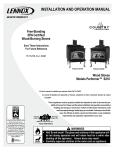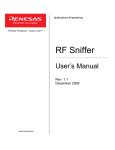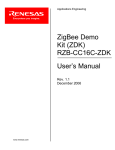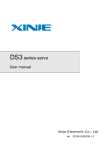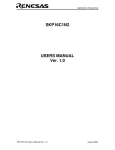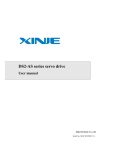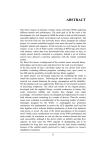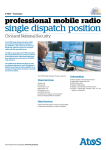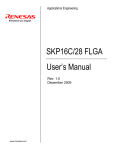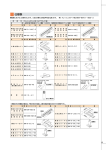Download RF Sniffer User Manual
Transcript
Applications Engineering Powerful Processors – Easy to Use™ RF Sniffer User’s Manual Rev. 1.00 August 2005 www.renesas.com Applications Engineering Table of Contents 1.0 Kit Overview.............................................................................................................................................3 2.0 RF Sniffer Board ......................................................................................................................................6 3.0 RF Sniffer Software .................................................................................................................................7 3.1. Drop Down Menu Items ......................................................................................................................7 3.1.1. File Menu......................................................................................................................................7 3.1.2. Sniffer Menu .................................................................................................................................7 3.1.3. Capture Menu...............................................................................................................................8 3.1.4. Display Menu................................................................................................................................8 3.2. Main Screen Buttons ..........................................................................................................................9 3.3. Capture Windows .............................................................................................................................10 3.3.1. Column Layout Window .............................................................................................................10 3.3.2. Display Filter Window.................................................................................................................11 3.4. Graphical Topology Window.............................................................................................................11 4.0 Updating the ZigBee Development Kit (ZDK) Board Firmware.............................................................13 4.1. Programming the ZDK Board with Sniffer Firmware ........................................................................13 4.2. Programming the ZDK Board with ZigBee Demo Firmware.............................................................14 5.0 Updating the RTA-FoUSB-MON Firmware ...........................................................................................15 5.1. Program the RTA-FoUSB-Mon as an RF Sniffer .............................................................................15 5.2. Program the RTA-FoUSB-Mon as an In-Circuit Debugger ..............................................................16 Appendix A. Software Installation ..........................................................................................................18 Appendix B. Driver Installation...............................................................................................................19 Appendix C. Troubleshooting Guide ......................................................................................................21 C.1 Manual Installation ............................................................................................................................21 C.2 Driver Problems ................................................................................................................................21 Appendix D. Reference Manuals ...........................................................................................................23 Appendix E. Board Schematic & BOM...................................................................................................24 RF Sniffer User’s Manual Rev 1.00 August 2005 Applications Engineering 1.0 Kit Overview Full Speed USB RF Sniffer Interface ( RTA - FoUSB - MON) 1.5Mbs Sync Serial Figure 1-1: RF Sniffer Kit LCD ZigBee RF Sniffer Board The RF Sniffer Kit is composed of three components as shown in Figure 1-1. 1. The RF Sniffer software runs on a PC with Windows O/S. The software allows you to analyze RF communication packets and protocol in a ZigBee network. You can also display a graphical representation of the ZigBee network topology. Figure 1-2: RF Sniffer Software Capture and Topology Windows RF Sniffer User’s Manual Rev 1.00 3/ 24 August 2005 Applications Engineering Bus or Target Power Switch Mini USB Connector 10-Pin Connector to Target Status LEDs: Capturing (red) – Sniffer in Capture Mode Rx Packet (green) – Receiving ZigBee packet STATUS (yellow) – RFSI Status POWER (red) – Power Figure 1-3: RF Sniffer Interface 2. The RF Sniffer Interface connects to a PC’s USB port on one side and to a Sniffer Target Board on the other side. The hardware used is an RTA-FoUSB-MON unit that has been programmed with a specific Sniffer firmware version to work as a communication interface between the PC software and the Sniffer board. The firmware is user programmable and you can change it to convert the RTA-FoUSB-MON back to its original function as an In-Circuit Debugger (ICD) and Flash-over-USB™ (FoUSB) Programmer for Renesas M16C Flash microcontrollers (MCU). For the purpose of this manual, we will call an RTA-FoUSB-MON that has been programmed with the RF Sniffer interface firmware RFSI, and a unit that has been programmed with the In-Circuit Debugger firmware ICD. The procedure for changing the RTA-FoUSB-MON firmware is described in this manual. Here are some of the RTA-FoUSB-MON highlights: • M37641F8HP (8-bit USB Renesas MCU) with 3.9KB RAM and 32KB Flash ROM. • Bus powered (powered by USB) or target powered selectable. No external power supply is needed when connecting to Renesas’ target boards. • Target connection through a 2×5-pin header with matching 6” cable. • Mini-USB connector with matching 6 ft. cable to connect to host PC. • Semtech USB upstream port filter, EMI, and ESD protection circuitry. All-in-one device reduces target system part count and complexity while providing internal circuit protection. • Works on Windows XP, Windows 2000, Windows ME, and Windows 98. 3. The Sniffer Target Board is based on a ZigBee Development Kit Board (ZDK) that contains RF transmitter and receiver, Renesas M30280FA Flash MCU, 2×8-character LCD, and hardware that allows you to run some ZigBee experiments. It comes pre-programmed with a specific firmware to provide the RF Sniffer functionality. RF Sniffer User’s Manual Rev 1.00 4/ 24 August 2005 Applications Engineering Figure 1-4: RF Sniffer Target Board RF Sniffer User’s Manual Rev 1.00 5/ 24 August 2005 Applications Engineering 2.0 RF Sniffer Board NOTE: The following chapters assume that you installed the required ZigBee Demo Kit software and USB drivers while following the QuickStart guide, parts 1 and 2. Please see Appendix A and Appendix B for software and driver installation details, if required. 1. Connect the RF Sniffer Interface’s (RFSI) 2×5 header ribbon cable to the RF Sniffer target board. 2. Make sure the RFSI’s Power Mode switch is set to the USB position. 3. Connect the RFSI to the USB port of your PC. The message “Renesas Sniffer” should appear on the Sniffer target board’s LCD. 4. Start the RF Sniffer software (Start > All Programs > Renesas > RF Sniffer V.x.xx > RF Sniffer). 5. Click the Connect button on the RF Sniffer Software Toolbar. It should change its color to blue and display “Disconnect” now instead of “Connect”. The channel selector to the right should be set to channel 24 (0x18). Figure 2-1: RF Sniffer Software Toolbar 6. Click the Capture button. The RF Sniffer software is now in capture mode. The LCD on the RF Sniffer board will display “Capture” on line 1 and “CH: 0x18”, which is the ZigBee channel number selected in the RF Sniffer software, on line 2. The RF Sniffer hardware is now listening on RF channel 24 (0x18) for ZigBee data packets. The red and yellow LEDs of the RF Sniffer board will illuminate, indicating that the board is in capture mode. When you click the Stop button in the RF Sniffer software, the two LEDs will go off and the LCD will display “Stopped”. While in capture mode, the Sniffer board’s green LED will blink whenever a new data packet is received. RF Sniffer User’s Manual Rev 1.00 6/ 24 August 2005 Applications Engineering 3.0 RF Sniffer Software The RF Sniffer software allows you to protocol and analyze RF communication packets in a ZigBee network. You can also display a graphical representation of the ZigBee network topology. This chapter explains the features of the software. 3.1. Drop Down Menu Items 3.1.1. File Menu Figure 3-1: File Menu Open Save As… Exit Open a file with previously captured ZigBee protocol data. Save the current displayed ZigBee protocol data to a file. When saving the file, you will be prompted to add comment about the saved data that will be displayed the next time you open that file. NOTE: Only the packets currently being displayed (not filtered out by the Display Filter) will be saved, not the entire collection of captured packets. Quit the RF Sniffer Program. You will automatically be disconnected from the Sniffer hardware if currently connected. 3.1.2. Sniffer Menu Figure 3-2: Sniffer Menu Connect Disconnect Info Connect to the RF Sniffer hardware. When connected, this menu item will be grayed out. Disconnect from the RF Sniffer hardware. When not connected, this menu item will be grayed out. Display RF Sniffer hardware Info (firmware revision, type of sniffer board). This function is only available when connected to the sniffer hardware. RF Sniffer User’s Manual Rev 1.00 7/ 24 August 2005 Applications Engineering 3.1.3. Capture Menu Figure 3-3: Capture Menu Start Capturing Stop Capturing Capture Filter Start capturing ZigBee network traffic. Stop the capture process. Set filter rules for which packets will be stored. Any packets that do not meet these rules will be automatically discarded. 3.1.4. Display Menu Figure 3-4: Display Menu Column Layout Display Filter Time Units Delta Time Define the column display order in the capture window and select which items are displayed. Apply rules to select which stored packets to display. Display time information in Microseconds, Milliseconds or Symbol Length. Define how the Delta Time between two successive ZigBee packets is measured: From the beginning of a packet to the beginning of the next packet, or from the end of previous packet to the beginning of the next packet. RF Sniffer User’s Manual Rev 1.00 8/ 24 August 2005 Applications Engineering 3.2. Main Screen Buttons Figure 3-5: RF Sniffer Main Screen Buttons Connect/Disconnect Capture RF channel Protocol Layer Clear Graphical Topology Toggle button to connect/disconnect from the RF Sniffer hardware. Clicking the white Connect button will establish a connection to the Sniffer hardware. The button’s color will change to blue and its text to Disconnect. Clicking the blue Disconnect button will disconnect the Sniffer software from the hardware. Toggle button to start/stop the ZigBee network traffic capturing process. Clicking the white Capture button will start the capture process. The button’s color will change to blue and its text to Stop. Clicking the blue Stop button will end the capturing process. Drop-down selection menu to select the ZigBee RF channel. The channel number is displayed in both decimal and hexadecimal values. The RF channel can only be changed while currently NOT capturing. NOTE: Valid channels for IEEE 802.15.4 systems are as follows: 900/868MHz Systems: ch0 - ch10 2.4GHz Systems: ch11 - ch26 Four selection buttons, labeled MAC, NWK, APS and ZDO allow you to determine the type of ZigBee protocol layer shown in the capture window. The current selected layer’s button is colored blue. Selecting MAC will show the raw data transmitted at the Medium Access Control Layer (IEEE 802.15.4 RF layer specification). Selecting NWK displays data at the ZigBee network layer. APS stands for ZigBee application layer and ZDO for ZigBee Device Object layer. The current version of the software does not yet support displaying data at the APS and ZDO layer levels. Pressing the Clear button deletes the entire collection of stored packets. Opens a new window with a graphical representation of the ZigBee networks topology. RF Sniffer User’s Manual Rev 1.00 9/ 24 August 2005 Applications Engineering 3.3. Capture Windows 3.3.1. Column Layout Window Figure 3-6: RF Sniffer Column Layout Window The Column Layout Window displays several columns of information about every ZigBee packet received. The order of the columns and the items displayed can be changed via the Display > Column Layout menu. The column headings in the screenshot shown in Figure 3-6 from left to right are: No. The packet number. Time The time in absolute Microseconds from the time the very first packet was received. Delta The delta time in Microseconds between the start of two packets. Packet Type The ZigBee packet type. Src PAN The Source PAN (Personal Area Network) address of the transmitting ZigBee node. Src Addr. Source Address. The address of the transmitting ZigBee node. Dest. PAN The Destination PAN address, i.e. the PAN to which the receiving node belongs. Dest. Addr. Destination Address. The address of the receiving ZigBee node. Info Information about the packet. The display in this column depends on the selected protocol layer (MAC, NWK, APS or ZDO) and the type of packet transmitted. Len The Length of the ZigBee packet in bytes. Seq. The Sequence number of the MAC header packet. LQI Link Quality Indication. LQI is a calculated value between 0 and 255 with a higher LQI number indicating a better link quality. CRC Cyclic Redundancy Check. ZigBee packets are transmitted with a CRC checksum for error recognition and correction. If “OK”, the packet was received without transmission errors. RF Sniffer User’s Manual Rev 1.00 10/ 24 August 2005 Applications Engineering 3.3.2. Display Filter Window Figure 3-7: RF Sniffer Display Filter Window Figure 3-7 shows the details of the ZigBee packet # 133 that was selected by clicking on the corresponding row in the column layout window above. The left windowpane shows the different components of the ZigBee packet: Packet Length, MAC Header, NWK Header and NWK Payload. The right windowpane shows the raw data bytes of the packet as both 8-bit hex values and ASCII code. Clicking on an entry in the left windowpane will highlight the corresponding hex values in the right pane in blue. In above example the 7-byte NWK payload is 00 00 00 01 FF AA 8C. Byte 1 = 00 indicates that a ZDK board transmits a new LED and sensor state. The next three bytes represent the status of the red, yellow and green LEDs respectively (00 = LED off; 01 = LED on). The next three bytes are the 8-bit analog values of the board’s potentiometer, light and temperature sensors, respectively. 3.4. Graphical Topology Window Click on the Graphical Topology button and a window will open showing you the ZigBee nodes that are members of the network, how they are interconnected, and the flow of information between them. In the example screen shot below, the node with address 0x071E is sending a packet to the node with address 0000 (the coordinator). RF Sniffer User’s Manual Rev 1.00 11/ 24 August 2005 Applications Engineering Figure 3-8: RF Sniffer Graphical Topology Window Topology Window Buttons: Always on top This button will force the Graphical Topology window to be above any other windo. Clear the Topology Window Display Clear This is a toggle On-Off button. The term CSkip refers to the Child-Skip algorithm outlined in the ZigBee specification. When this button is left "On", the topology of the network will be determined by the source addresses of each captured packet using the CSkip algorithm and the values of Cm-Rm-Lm button. Cm#,Rm#,Lm# This button is used to show and set the current network configuration parameters for the ZigBee CSkip algorithm. These values must match your current network configuration to produce an accurate topology representation. Use CSkip Note: For the software to be able to display the graphical topology of the network without using the CSkip button, the RF Sniffer software must be connected to the Sniffer hardware and the Capture mode must have been started before the ZigBee network is being established, i.e. before any ZigBee device is being switched on and joins or establishes the network. RF Sniffer User’s Manual Rev 1.00 12/ 24 August 2005 Applications Engineering 4.0 Updating the ZigBee Development (ZDK) Board Firmware Kit Your ZigBee Development Kit contains one ZDK board that comes pre-programmed with the required RF Sniffer firmware. In this chapter, we show you how you can update or replace this firmware. You can skip this chapter if you do not intend to update the ZDK board’s firmware. To update the firmware of the ZDK board, you need an RTA-FoUSB-Mon that is programmed to function as an In-Circuit Debugger (ICD) and Flash-Over-USB Programmer, referred to as ICD hereafter. Please see chapter 5.0 on how to re-program your RTA-FoUSB-Mon unit if you only have a single unit that is programmed as a Sniffer interface. 4.1. Programming the ZDK Board with Sniffer Firmware 1. Connect the ICD’s 2×5 header ribbon cable to the ZDK board. 2. Make sure the ICD’s Power Mode switch is set to the USB position and the ZDK board’s power switch is set toward the ICD connector. 3. Connect the ICD to the USB port of your PC 4. Start the FoUSB software (Start > All Programs > Renesas > Flash-Over-USB V.x.xx > FoUSB Programmer). To be able to program a target board successfully, both the selected MCU type of the FoUSB programming software and the MCU Monitor Image (MMI) loaded into the ICD must be identical to the MCU type that is on your target board. The FoUSB software remembers the type of the last MCU you have programmed. If it detects a mismatch between the remembered MCU type and the MCU type of the ICD’s MMI code (also called USB monitor code), it will prompt you to update that code. However, before you click OK on the popup window that offers to update your ICD, you must determine the correct course of action: Is the ICD’s MCU type identical to your target board’s MCU type? • If the answer is ‘yes’: Click No in the popup window that offers to update your ICD’s USB monitor code. The FoUSB software will then prompt you to select the MCU. Select the correct type that sits on your target board. FoUSB will connect to the target board and unlock the MCU, then show it is connected as in the figure below. Figure 4-1: FoUSB Software Connected to Target Board • If the answer is ‘no’, then: Is the FoUSB software’s remembered MCU type identical to your target board’s MCU type? If the answer is ‘no’: Click No in the popup window that offers to update your ICD’s USB monitor code. FoUSB will then prompt you to select the MCU type. Select the correct type that sits on your target board. Now the FoUSB software’s MCU type matches the one of your target board, but the RF Sniffer User’s Manual Rev 1.00 13/ 24 August 2005 Applications Engineering ICD’s MMI code still does not match. Consequently, FoUSB will again offer to update the ICD. Continue with the ‘yes’ section below to update the ICD. If the answer is ‘yes’: Update the ICD. Important: the ICD has to operate at 5V to update its MMI code. However, if the ICD is connected to the ZDK target board, its voltage is pulled down to the 3.3V operating voltage of the target board’s MCU. Therefore, disconnect the ZDK target from the ICD. Now click OK to update the MMI code. After the MMI update has completed, reset the ICD by unplugging the USB cable, reconnecting the ICD to the target board and then reconnecting the USB cable. 5. The FoUSB software should now automatically detect and unlock the target board’s MCU and display the MCU type without having to select the device. 6. Click Open in the left of the FoUSB program window and browse to the directory in which the Sniffer firmware is stored (C:\Renesas\RFSniffer\Firmware). Note that there are three different versions of ZDK boards available, each of which needs a different firmware file. You need to select the firmware file that matches your ZDK board’s hardware. • M16C/28 MCU with Chipcon RF (Sniffer_CC28_V.x.xx.mot) • M16C/28 MCU with ZMD RF (Sniffer_ZMD28_V.x.xx.mot) (future release) • M16C/6P MCU with Freescale RF (Sniffer_FS62P_V.x.xx.mot) (future release) 7. A popup window displays the ID code of the firmware file you just opened. Click OK. 8. Click Program in the left of the FoUSB program window. 9. In the Program Flash Window that pops up, make sure “Only Erase Blocks Needed” is checked. Click Program. It is important that you only erase the blocks needed and not the entire Flash memory, as each ZDK board stores a unique 8-byte MAC address that is factory programmed at Flash memory address 0xF000. You do not want to erase the MAC address, because the board will not be able to function without one. 4.2. Programming the ZDK Board with ZigBee Demo Firmware The procedure for programming a ZDK Board with the ZigBee Demo firmware is the same as described in chapter 4.1, with the exception of the files that you need to open for download in step 6. The ZDK board demo firmware is located in the directory C:\Renesas\RZB_CC16C_ZDK\Demo. The filename of the demo firmware that came pre-loaded on your ZDK boards is ZDK_Demo_Vxx.mot, where xx is the version number of the code. RF Sniffer User’s Manual Rev 1.00 14/ 24 August 2005 Applications Engineering 5.0 Updating the RTA-FoUSB-MON Firmware This section discusses how to update the firmware of the RTA-FoUSB-MON hardware to function either as an RF Sniffer Interface (RFSI) or as an In-Circuit-Debugger (ICD) and Flash-Over-USB Programmer. Future versions of the RF Sniffer software may require that you update the RFSI firmware of your unit. The ZigBee Development Kit contains an RTA-FoUSB-MON unit that has been pre-programmed to function as an RFSI. Therefore, you only need to read this section if you must update the firmware of the RFSI due to a new software release, or if you want to change the functionality of a unit from RFSI to ICD or vice versa. The RTA-FoUSB-MON has a boot mode that can be used to program the MCU’s user Flash area. The procedure to activate the boot mode to re-program the Flash firmware is described in the following steps. 5.1. Program the RTA-FoUSB-Mon as an RF Sniffer 1. Unplug the RTA-FoUSB-MON unit from both its target and from the USB cable. 2. Remove the black plastic case. 3. Shunt JP1 with a 2.54mm (0.100 mil) jumper. This will configure the RTA-FoUSB-Mon to run in boot mode when it is powered up. Figure 5-1: Jumper JP1 Location 4. Make sure that the power mode switch is set to the USB position. 5. Plug the USB cable back in. The RTA-FoUSB-Mon will now be in boot mode and will communicate as a USB device to the PC. In boot mode, the RTA-FoUSB-Mon uses a different USB Driver than the RF Sniffer application, so you will need to load another USB Driver when doing this procedure for the first time. The Windows New Hardware Wizard should automatically start and guide you through the installation of the required USB driver. The driver is located in C:\Renesas\FOUSB\USB Drivers. RF Sniffer User’s Manual Rev 1.00 15/ 24 August 2005 Applications Engineering Figure 5-2: Flash-Over-USB with RTA-FoUSB-MON in Boot Mode 6. Open the Flash-Over-USB program. Note that the MCU device name displayed in green on the front screen will automatically change to M37641F8 (the MCU inside the RTA-FoUSB-Mon) without having to select that device. 7. Click on the Open button and load the file Sniffer_FoUSB_V.x.xx.hex, located in C:\Renesas\RFSniffer\Firmware. 8. Click on the Program button to program the new firmware to the RTA-FoUSB-Mon’s microcontroller. 9. Unplug the USB Cable, remove the jumper and enclose the board back into its case. Now reattach the ribbon cable to your RF Sniffer target board and re-connect the RTA-FoUSB-Mon unit to your PC with the USB cable. 10. Start the RFSniffer Application program (Start > Renesas > RF Sniffer V.x.xx > RF Sniffer) and click on the Connect button. The button will change its label to “disconnect” and change its color to blue. Click the Capture button. The LCD of the RF Sniffer board should display “Capture” if the RTA-FoUSB-Mon unit successfully connects to the target board. 5.2. Program the RTA-FoUSB-Mon as an In-Circuit Debugger 1. Unplug the RTA-FoUSB-MON unit from both its target and from the USB cable. 2. Remove the black plastic case. 3. Shunt JP1 with a 2.54mm (0.100 mil) jumper. This will configure the ICD to run in boot mode when it is powered up. Figure 5-3: Jumper JP1 Location 4. Make sure that the power switch is set to the USB position, so that the unit is powered via the USB bus. 5. Plug the USB cable back in. The RTA-FoUSB-MON will now be in boot mode and will communicate as a USB device to the PC. In boot mode, the RTA-FoUSB-MON uses a different USB Driver than the In-Circuit Debugger/Programmer application, so you will need to load RF Sniffer User’s Manual Rev 1.00 16/ 24 August 2005 Applications Engineering another USB Driver when doing this procedure for the first time. The Windows New Hardware Wizard should automatically start and guide you through the installation of the required USB driver. The driver is located in C:\Renesas\FOUSB\USB Drivers. 6. Open the Flash-Over-USB program. Note that the MCU device name displayed in green on the front screen will automatically change to M37641F8 (the MCU inside the RTA-FoUSB-Mon) without having to select that device. 7. Click on the Load MMI button on the right. This opens a chip selection window. Figure 5-4: Load MMI Button 8. Select the MCU device of your target board to which you want to connect the RTA-FoUSB-Mon as an In-Circuit Debugger (not the MCU of the RTA-FoUSB-Mon unit) and click the OK button to load the selected MCU Monitor Image (MMI) to the RTA-FoUSB-Mon. Figure 5-5: Chip Selection Window 9. Unplug the USB Cable, remove the jumper and enclose the board back into its case. Now reattach the ribbon cable to your target board and re-connect the RTA-FoUSB-Mon unit to your PC with the USB cable. 10. After you connect the RTA-FoUSB-Mon to the PC, the FoUSB Programmer should show the target MCU device name you selected earlier. RF Sniffer User’s Manual Rev 1.00 17/ 24 August 2005 Applications Engineering Appendix A. Software Installation Before using the RF Sniffer Kit, you need to install the required software files and applications. Do not plug the RF Sniffer Interface (RFSI) into your PC until the installation process is finished. The installer will automatically detect prior installations of the software and prompt you to remove those before continuing. Please insert the enclosed CD into your computer’s CD-ROM drive. The CD should auto-start, displaying the ZigBee ZDK Install Screen. Select “ZigBee ZDK For M16C”. Follow the directions in the installation windows to install the ZDK demo software tools and the RF Sniffer software. If the installation screen does not appear, please browse to the CD root folder and double-click on ZDK_Installer.exe. Please review the QuickStart Guide, which may contain information about the RF Sniffer that was not yet available when this user manual was printed. If you experience problems with the install software, please see chapter “C.1 Manual Installation” in Appendix C. . RF Sniffer User’s Manual Rev 1.00 18/ 24 August 2005 Applications Engineering Appendix B. Driver Installation The RF Sniffer Interface (RFSI) unit requires the installation of a USB device driver on the PC that is different from the USB drivers used for In-Circuit Debugger (ICD) units. For RF Sniffer mode there is one USB driver: MITSUUSB.SYS This USB driver is used for RTA-FoUSB-MON hardware that has been programmed with the RF Sniffer firmware. The driver files (.sys and .inf) are always located under the RFSniffer install directory (e.g. C:\Renesas\RFSniffer\USB Driver) in case you are having trouble with the automatic driver installer. First, verify that the Power Mode switch (S1) on the RTA-FoUSB-MON is in the USB (Bus powered) position. Next, connect the RF Sniffer Interface to your PC using the supplied USB cable. If you are running Windows 98SE, 2000, or ME no user intervention is needed. When the RF Sniffer Interface unit is plugged in, Windows automatically attaches the correct driver for your device and it is ready to use. If you are running Windows XP, the first time an RF Sniffer interface is plugged into a different USB port on the PC, the Windows XP “Found New Hardware Wizard” window will appear. Select the default option “Install the software automatically (Recommended)” as seen below. Figure B-1: Found New Hardware Wizard Windows will then begin installing the USB driver. Another screen may appear stating that this driver has not been XP certified by Microsoft because we did not participate in Microsoft XP driver certification. Click Continue Anyway. Your driver is now installed. Click Finish to close the wizard. RF Sniffer User’s Manual Rev 1.00 19/ 24 August 2005 Applications Engineering Figure B-2: Continue Anyway and Finish Screens RF Sniffer User’s Manual Rev 1.00 20/ 24 August 2005 Applications Engineering Appendix C. Troubleshooting Guide This section discusses possible problems you may encounter while installing the RF Sniffer software and drivers. This section also discusses the countermeasures and solutions to resolve these problems. For troubleshooting information on the Flash-Over-USB programming software, In-Circuit Debugger and Renesas HEW, see the ZDK Kit User’s Manual. If, for any reason, you cannot resolve the problem, please contact your Renesas representative for assistance. C.1 Manual Installation Before connecting the RF Sniffer Interface to your PC, the driver files (.inf and .sys) and executables must be copied to the C:\Renesas\RFSniffer directory. To do this, double-click RFSniffer_V.xx.exe under \Tools\RFSniffer directory on the CD. After the RF Sniffer install, assuming the default directory was used, a C:\Renesas\RFSniffer subfolder should have been created. The Windows USB drivers for the RF Sniffer Interface are located in the C:\Renesas\RFSniffer\USB Driver directory. The driver files are: mitsuusb.sys and RF_Sniffer.inf. The C:\Renesas\RFSniffer folder contains all the latest documentation about the RF Sniffer software and hardware. NOTE: If you are using Windows 2000 or XP, you will need Administrator privileges to be able to install the drivers. (1) Windows 2000 (a). Install RF Sniffer software by double-clicking on RFSniffer_V.xx.exe from the \Tools\RFSniffer folder of the CD. (b). Copy the RF_Sniffer.inf file from C:\Renesas\RFSniffer\USB Driver folder to \WINNT\INF folder. (c). Copy the mitsuusb.sys file from C:\Renesas\RFSniffer\USB Driver folder to \WINNT\SYSTEM32\drivers folder. (2) Windows 98 (a). Install RF Sniffer software by double-clicking on RFSniffer_V.xx.exe from the \Tools\RFSniffer folder of the CD. (b). Copy the RF_Sniffer.inf file from C:\Renesas\RFSniffer\USB Driver folder to \WINDOWS\INF folder. (c). Copy the mitsuusb.sys file from C:\Renesas\RFSniffer\USB Driver folder to \WINDOWS\SYSTEM32\drivers folder. C.2 Driver Problems This part discusses how to fix common problems that may occur with USB driver installation. The most common problem is that Windows did not properly install the USB drivers and so the RFSI is not recognized. When checking the device status in the Windows Device Manager (Start > Control Panel > System > Hardware > Device Manager > Universal Serial Bus controllers > Renesas RF Sniffer), it RF Sniffer User’s Manual Rev 1.00 21/ 24 August 2005 Applications Engineering will indicate that the device is not working properly. A further indication of this problem is the faster blink rate of the RFSI’s Status LED (yellow) of about 2-3 times per second. When the driver is installed properly, the Status LED only blinks once every second. Before trying the following steps, try re-starting your PC to see if this resolves the problem. You can check the status using the Device Manager. If the Renesas RF Sniffer appears under the Universal Serial Bus Controllers with no red X or yellow exclamation point, the driver was installed properly. For cases where the “Device Status” states the device is not working properly, please try the following: 1. 2. 3. 4. Double-click on Renesas RF Sniffer. A Renesas RF Sniffer Properties dialog box appears. Click on Driver tab and click on Update Driver button. Select “Display a list…” and click on Have Disk button. Locate the C:\Renesas\RFSniffer\USB Driver directory and install the mitsuusb.sys driver. 5. If this process does not work, please follow the instructions below. For cases in which the driver was not installed properly by Windows (Windows 98, Windows 2000) or is not listed in the Device Manager > Universal Serial Bus controllers, please try the following: 1. Unplug the USB Cable so Windows removes the driver from memory. 2. Delete the driver mitsuusb.sys from \WINNT\SYSTEM32\DRIVERS\ folder in Windows 2000 or \WINDOWS\SYSTEM32\DRIVERS folder in Windows 98. 3. Plug in the RFSI and try installing the driver as described above, using the driver from the C:\Renesas\RFSniffer\USB Driver directory. RF Sniffer User’s Manual Rev 1.00 22/ 24 August 2005 Applications Engineering Appendix D. Reference Manuals Item Title Description 1. Renesas ZigBee Demonstration Kit (ZDK)Quick Start Guide Document that will help you get started on using the ZigBee demonstration Kit. 2. 3. RF Sniffer User’s Manual ZDK Board Schematic 4. 5. 7. ZDK Board BOM M16C/20/60 Series C-Language Programming Manual M16C/20/60 Series Assembler Language Programming Manual HEW User’s Manual 8. 9. 10. AS30 User’s Manual NC30 User’s Manual RTA-FoUSB-MON User’s Manual This document. Schematic diagram for the RF Sniffer and ZDK boards. Bill of materials for the ZDK board. ANSI C-language programming guide for the M16C/20/60 series MCU. Assembly language programming guide for the M16C/20/60 series MCUs. This document describes installation and operation of the Integrated Development Environment for Renesas’ Tools. Guide for AS30 assembler. Guide for NC30WA C-compiler. In-Circuit Debugger and Programmer User’s Manual 6. NOTE: The installer will copy all these manuals during installation. They can be accessed using the Document Descriptions file by clicking on Start > Programs > Renesas > RZB_CC16C_ZDK > All Manuals and Documents RF Sniffer User’s Manual Rev 1.00 23/ 24 August 2005 Applications Engineering Appendix E. Board Schematic & BOM The circuit board schematic and Bill-Of-Materials (BOM) are available as separate PDF documents. They can be accessed through Start > Programs > Renesas > RZB_CC16C_ZDK > All Manuals and Documents, or by browsing to the folder C:\Renesas\RZB_CC16C_ZDK\Docs and opening the files: RZB_CC28_BRD_BOM.pdf RZB_CC28_BRD_Schematic.pdf RF Sniffer User’s Manual Rev 1.00 24/ 24 August 2005
























